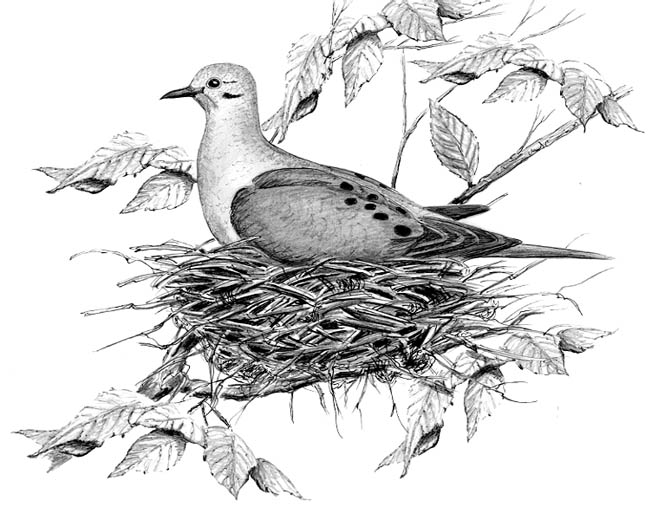
Dear Bird Folks,
About two weeks ago I discovered a Mourning Dove nesting in one of the plants on my second story deck. At first there was one egg and then a few days later a second one appeared. Now Mrs. Dove sits absolutely motionless on her nest all day long, except for the rare eye blink. Her mate (the skunk) has never returned to feed her. I’ve put out small a saucer of water, but how do I provide her with food? Should I put out some seeds? Do you think those eggs will ever hatch? What to do?
-Connie, Millbrook, NY
How sweet, Connie,
What a sweet visual you painted. I can just picture the mother dove nestled amongst your flowers, keeping dead still, with only her watchful eyes blinking occasionally. Even as the blazing sun beats down the dedicated female refuses to budge, shading her fragile eggs, without so much as a sip of water to quench her thirst. Then, like Molly Pitcher, you arrive with a refreshing beverage, to help her survive the heat of the day. Boy, Connie, if I’m ever hot, thirsty, and in Millbrook, NY, I’m definitely going to look you up. You sound like the perfect hostess. Just one thing though; instead of giving me a saucer of water, could you substitute a large glass of chocolate milkshake? I’m trying to cut back on my water intake.
The Mourning Dove is one of the most common birds in the United States, yet this generic-looking bird often fails to get our attention. We get all excited when we see cardinals, bluebirds, orioles or hummingbirds at our feeders, but the lowly dove, much like a yellow traffic light, is usually ignored. It’s too bad because Mourning Doves, as you probably already know, Connie, are fairly attractive birds. They have sleek bodies, warm brown feathers, long tapered tails and with close inspection a distinctive bright blue around the eyes, making them look like a young Tammy Faye. And one more thing, the sexes are practically identical. That last part is important because in it lies the answer to your question.
To a casual observer the Mourning Dove is number one on the clueless bird chart. They are often nabbed by predators, seem to constantly smack into our windows and they land awkwardly on feeders, as if they have just come back from the local happy hour. In reality, Mourning Doves are an extremely successful species. They have adapted well to humans, can survive in all sorts of habitats, and when it comes to breeding dove couples are the poster birds for equality. These “clueless” birds are totally clued in to what it takes to properly raise a family.
Once paired up the male dove heads off to find the perfect nesting site. As soon as the site is chosen the female takes over. She is the one that does the actual building, but her mate stays busy bringing her a steady supply of building materials, which are mostly small twigs. The delivery of the twigs is a show in itself. Instead of flying to the nearest branch to deliver the twigs, the male dove has the odd habit of landing directly on the back of the nest-building female. While balancing on his mate’s back he offers her a twig. I’m not sure why he chooses such a weird delivery method. Perhaps the “happy hour effect” doesn’t apply only to landing on feeders.
The female of course lays the eggs, which are usually just two. After the eggs are laid the male dove is more than willing to take his turn at incubating. He typically relieves the female around midmorning, so she can go off and watch her stories. She then returns later in the afternoon so the male gets in his before-dinner nap. After two weeks of incubation, the new chicks hatch out of the eggs and then things really get strange, but equal.
Last week I wrote about goldfinches and how the young birds are fed nothing but seeds. This is unusual because most growing chicks need more protein than seeds alone can provide. Well, Mourning Doves are also strict seedeaters, but they are too big of a bird to grow up on seeds alone. So the parents provide food in a rather mammalish manner. Instead of gathering food to shove down the nestlings’ throats, both adults produce something called “pigeon milk,” which they feed to the chicks. Pigeon milk is produced in the adult’s crop. It is yellowish in color and looks a lot like cottage cheese, bad cottage cheese, which of course is redundant. Pigeon milk sounds gross, but tests show that it contains more fat and more protein than either cow or human milk, and really isn’t all that bad when severed with Oreos.
Yes, Connie, I do think your doves’ eggs will hatch. With a population that is estimated to be around 400 million birds, Mourning Doves clearly know how to breed successfully. And you don’t need to provide Mrs. Dove with either food or water. Half the day she is sitting on the nest, but the other half of the day her identical-looking husband, “the skunk,” is there, so she can go out for lunch. If you want put out something, put out a plate of Oreos. It will help the baby doves get that gross pigeon milk down.